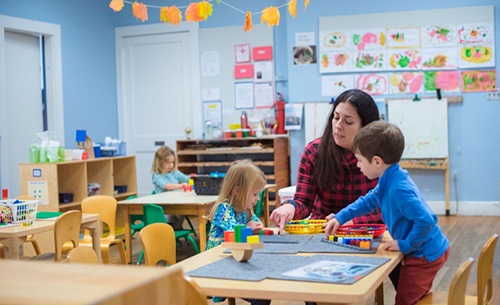Teachers: the Most Important Leaders of All
| March 2014Are You a Leader?
You may not think of yourself as a leader, but you probably are. There are all kinds of leaders: the conventional ones—CEOs, managers, coaches, principals of schools, or directors of centers—and the more subtle, but just as influential, leaders we encounter in daily life. For example, the first person to push the elevator button, those who wade to the water’s edge first, those who pull off their shoes and socks to feel the grass with their feet at the first sight of Spring, people who say “hello” first, or the one who’s the first to smile. And, of course, teachers.
What is a Leader?
Leaders are people whom others look to for guidance. As a teacher, children look to you for guidance and reassurance every day. Seems like one of the most significant leaders of all and yet, teachers rarely see themselves as leaders. Here are some of the things that successful leaders in any arena do to inspire and help others. As you read through the list, think how you may demonstrate these attributes in your classroom. I bet you do!
How do Successful Leaders Lead?
Successful leaders guide others by:
- Developing an individual relationship with each member of his or her team.
- Assessing and recognizing a person’s current skills and giving him or her opportunities to enhance and develop new skills.
- Providing specific and clear expectations for the team member.
- Listening to a person’s feelings of accomplishment, anger or frustration, and helping them develop a positive, solution-oriented attitude.
- Helping staff members resolve conflict with others.
- Redirecting and coaching a person to be more successful.
- Giving team members, through delegation, opportunities to be more self-sufficient and learn additional skills.
Teachers as Leaders in the Classroom
Do those seven attributes sound like how you work and interact with the children in your classroom? They do. It’s amazing how so many of the goals we have for children are the same as those for adults.
Now, let’s take the above list and apply it directly to working with children. You can begin to see even more clearly how you, as a teacher, are a leader.
What does a teacher do? A teacher engages the children by:
- Developing individual relationships with each child.
- Celebrating a child’s current skills and giving him opportunities to enhance and develop new skills.
- Providing routine and clear expectations for the child.
- Validating a child’s feelings of accomplishment, anger, or frustration.
- Helping the child resolve conflict with others.
- Redirecting the child to appropriate behavior.
- Giving the child opportunities to learn self-help skills.
Similarities in Guiding Children and Guiding Adults
The table below lets you take a look at the two lists, guiding children and guiding adults, side by side. The similarities are remarkable.
Guiding Children |
Guiding Adults |
|
Relationships |
Develops individual relationships with each child |
Develops individual relationships with each staff member |
Skills |
Celebrates current skills |
Recognizes and builds on current skills |
Expectations |
Conveys simple, age-appropriate expectations |
Provides job description and clear expectations |
Emotions |
Validates children’s emotions and helps them to express themselves appropriately |
Listens to staff member’s feelings and encourages a solution-oriented attitude |
Conflict |
Helps the child learn to resolve conflict |
Guides staff members to resolve conflicts on their own and helps when necessary |
Behavior |
Redirects the child to appropriate behavior |
Coaches the staff to meet job expectations |
Self-Sufficiency |
Gives the child opportunities to learn self-help skills |
Delegates to help staff become more self-sufficient |
A True Leader of any type is a Teacher
Maybe a true leader, conventional or non-conventional, is in many ways, really a teacher. A teacher who coaches and encourages and listens. Your impact as a teacher is probably greater than you ever imagined. So feel like a leader and act like a leader because children look to you for encouragement and guidance at all times. Every smile, touch, and word you say potentially impacts a child.
Lead well, little ones are watching!







